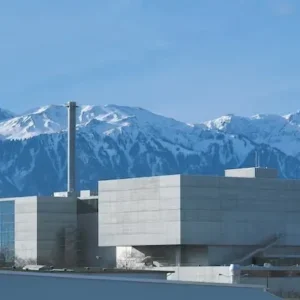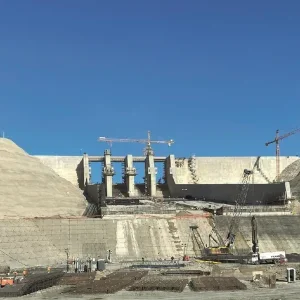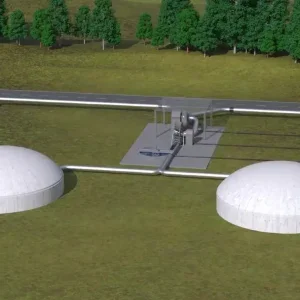THE TRADITION-BOUND world of analysing dams is undergoing something of a seismic event as engineers use finite element modelling (FEM) and finite element analysis (FEA) to solve the problems of old concrete dam safety assessment. FEM/FEA is challenging overly conservative assumptions of the past, and taking advantage of structural characteristics that were too complex to evaluate years ago.
By replacing older, more simplified modeling studies, FEM/FEA is challenging overly conservative assumptions of the past, and taking advantage of structural characteristics that were too complex to evaluate years ago.
Pushing for changes to the way engineers in the dam industry look at these structures are firms like URS Corporation’s Dams Division in Denver, Colorado, US. The company notes that traditional analysis methods can generate overly conservative results, making it appear that a dam requires rehabilitation to meet current safety standards when, in fact, it does not.
The safety of concrete dams is regulated by state and federal agencies; when safety is questioned, regulators can require that reservoirs be lowered. However, this can disrupt the available natural resource, causing not only economic loss for the owner but also social and environmental loss for the public. The dam’s value in hydro power generation, water storage or flood control may be sharply reduced.
Legacy of the past
Many of the thousands of concrete dams in the US were designed and built decades ago, when safety guidelines were less stringent and evaluation techniques more simplified than they are today. Yet, many engineers still use the traditional, simplified methods to quickly evaluate the current safety of dams. URS notes that traditional analysis methods can generate overly conservative results, making it appear that the dam requires rehabilitation to meet current safety standards when, in fact, it does not.
‘In actual fact, concrete dams – even those built as long ago [as] the late nineteenth and early twentieth centuries – are still doing a great job,’ says Guy Lund, engineering analysis leader for the URS Dams Division. ‘Fears of concrete dam failures that result in floods are way overblown.’
Most of the FEM/FEA work at the Denver Dams Division offices is done using the ANSYS Mechanical Environment, design verification and optimisation software. The license includes structural and thermal analyses. Technical support and software training are provided by JLR The Engineering Solutions Co. of Everett, Washington, US.
The main benefit to URS clients from ANSYS is that by taking full advantage of the structure’s strength, the amount of money needed for safety rehabilitation is reduced or eliminated. Since the costs of dam rehabilitation projects can run into millions of dollars, any reduction or elimination of upgrades or rehabilitation is a benefit to all who rely on the dam and its resources.
The goal of these analyses, URS notes, is to keep these structures in service, to pinpoint upgrades that are needed, and to minimise or eliminate unneeded costs associated with any rehabilitation.
‘URS uses ANSYS to study concrete dams and has shown that many of the structures are safe as they stand, and that many recommended ‘fixes’ are unnecessary. Sometimes, the ‘fixes’ have been suggested to mollify alarmists and well-intentioned but ill-informed critics,’ Lund says.
The modelling challenges
Properties
Where remote location makes physical sampling and testing of the concrete and foundation bedrock costly and impractical, URS performs sensitivity studies on the foundation and concrete to identify material properties that drive the structural behaviours and outcome.
‘One very real problem for engineers and many of the dam owners is a lack of material data,’ Lund says. ‘Gathering the data is costly, and still may not give the engineers all the information needed to truly understand the material behaviour of the concrete and foundation rock. We collect samples where it is practical but, still, you are estimating the material behaviour of a dam that might be 300ft [91.4m] tall and 800ft [243.8m] long based on several 6 inch [0.15m] diameter samples. You can always miss something.’
Typically, the initial physical properties of the concrete and foundation are based on data from the US Bureau of Reclamation, US Army Corps of Engineers, the American Concrete Institute (ACI), and the Federal Energy Regulatory Commission. ‘The power of the ANSYS pre and post-processor then allows our engineers to evaluate several different assumptions; material properties, load magnitudes and geometrical anomalies, and pinpoint the information that has the greatest influence on the safety of the dam,’ Lund says. ‘This is quick and economical and helps engineers to refine site investigations so that only the most appropriate data is collected.’
Structural behaviour
Lund thinks that dam analysis is a very unique science. ‘A number of times URS has been retained to re-evaluate studies performed by others because the previous work failed to demonstrate an understanding of and experience in the engineering of concrete dams.
‘It may seem that concrete arch dams, for example, are relatively simple arches. However, there are actually two or three additional different structural systems acting within the dam. In addition, the effects of the foundation must be included in the FEM to properly simulate the behaviour of the structure,’ he explains.
Lund and his team of five analysts claim they are pushing the capabilities every day, improving the modelling of the foundation, non-linearities, soil/ and reservoir/structure interaction. As the capability of computer hardware and software increase, the more complex models are becoming more economical. This will mean more detailed, larger and more accurate models, involving more and more non-linear structural and material properties and contact elements.
‘We always try to keep the complexity of the models to a minimum, because it is easy for analysts to develop tunnel vision, and become more interested in the solutions to the numerical model, than the solutions to the problem,’ Lund points out. ‘However, when necessary, it is great to have a FEA package that can handle simple as well as complex problems and ANSYS does that for our group.’
Solid elements
‘The best way to simulate the behaviour of a typical concrete dam is with solid elements,’ Lund notes. Interestingly, the same elements are used to model both the concrete and the foundation. ‘For the purposes of these kinds of analyses, rock and concrete behave pretty similarly,’ he says.
To simulate the mass concrete (which typically excludes reinforcement) and the foundation, URS uses the two or three dimensional structural solid elements (Solid42 and Solid45). URS uses the variable-node, isoparametric element (Solid95) with mid-side nodes for more complex structures. In situations where the dams include reinforcement steel in the concrete, URS engineers have also used the reinforced concrete element available in ANSYS (Solid65).
Non-linearities
According to Lund, the team has been successful using linear analysis techniques to simulate the standard structural behaviour of dams for normal, flood and seismic loading conditions. ‘We do incorporate non-linear assumptions into the models to simulate non-standard structural and material behaviours when necessary, such as structural behaviours [like] cracks and joints and material characteristics, such as for soils.’
One critical part of concrete dam analysis involves simulating the discontinuities in the dam, such as the vertical joints between adjacent concrete monoliths, and the interface between the base of the dam and the foundation bedrock. The new ANSYS Contact170 series elements are used to represent these discontinuous surfaces, where there is no structural connection other than friction. These elements can model opening and closing of the interfaces, sliding and friction resistance.
Sometimes the foundation consists of soils, or a portion of the dam base is back-filled with sediment or soil. For these situations the material non-linearities associated Drucker-Prager (Mohr-Coulomb failure criteria for granular material) and multi-linear stress-strain are used to simulate different types of soils.
Reservoir / structure interaction
URS is continuing to develop ANSYS macro routines that will allow more economical modelling of conditions that are currently represented by simple assumptions. ‘During an earthquake, for example, the reservoir and dam interact with each other resulting in an increase in the structure’s inertia and forces from dynamic pressure waves in the reservoir,’ Lund explains. ‘Theses additional forces can potentially reduce the safety of the dam, which is a headache for dam owners.
‘These dynamic loads are a headache for engineers too, because of all the many [different] technical arguments [about] how best to represent the impacts of reservoir and dam interaction. Currently, the accepted practice models these interaction loads using added-mass theories. For now, URS typically models the dam and reservoir interaction during earthquake events as an added mass to the dam structure using ANSYS Mass21 elements. However, it is becoming necessary in some situations to actually model the reservoir using fluid elements. ANSYS also handles [these] complexities,’ he adds. ANSYS’ ability to model the reservoir using incompressible fluid elements (Fluid 79, Fluid 80) has also been used.
Modelling dam/reservoir interaction using fluid elements is currently the technical area URS is refining for use in these complex studies. These more complex models must account for foundation damping of the reservoir pressure waves, external boundary conditions and compressible or incompressible fluids.
Currently, the governing agencies accept modelling reservoir/structure interaction with either mass or fluid elements. However, most safety criteria are still based on the mass theories. ‘In the future, as the dynamic impact between the reservoir and dam is better understood, more modelling will be preformed using the ANSYS fluid elements,’ says Lund.
Thermal
The behaviour of large structures like concrete dams, roller compacted concrete (RCC), and bridge piers is significantly influenced by the temperature loads from both internal (heat of hydration) and external (temperature fluctuations of the air and reservoir) sources.
‘In a typical concrete dam a 60oF (15.6oC) change can create as much as a 1000psi stress change in the dam’s concrete,’ Lund says. Therefore, detailed thermal analyses are performed to determine the effects the temperature load has on the structure’s behaviour.
‘ANSYS makes performing thermal analyses easy,’ he adds. ‘First, a numerical model is developed to simulate the typical structural loads on the structure, such as gravity, reservoir and earthquakes. Second, using ANSYS capabilities, the model is changed from structural to thermal elements in one simple command. The fluctuating temperatures due to external and internal sources are applied to model, and the temperature studies evaluated.
‘Finally, with one command the temperature distribution within the structure is applied to a structural model, again using ANSYS capabilities, which allows engineers to evaluate how changes in temperature affect the behaviour of the structure.’
ADPL advantage
With so many property assumptions, complex geometry and different element types, the book-keeping required to keep all studies straight can become a nightmare. This is where the ANSYS Parametric Description Language (APDL) becomes helpful. Lund explains: ‘Our engineers can quickly change material, geometric, and loading assumptions using ADPL and perform several different analyses, keeping bookkeeping to a minimum. [APDL] is used all the time with all the inputs that must be managed and run as batch files. It is one of the keys to the savings we get from ANSYS.
‘For example, the nodes are quickly defined, the model meshed, loads applied, solution run and results post-processed all using the APDL,’ he continues. ‘We start in the APDL input-deck format and generate models from text files. That is one of the most powerful benefits of APDL. We have developed macros to quickly generate complete dam-and-foundation models.’
He adds: ‘The new, improved ANSYS solid-modelling tools have slashed modelling time to man-hours now, down from several man-days just a couple of years ago and man-weeks a decade before that.’
In its dynamic models, the behaviour of the dam/reservoir interaction is simulated with ANSYS Mass21 elements. ‘These elements add considerable complexity to the model because the real properties associated with the Mass21 elements are dependent on the accelerations of the earthquake, depth of the water and the load’s angle to the convex surface angle of the dam’s reservoir side,’ Lund says. ‘APDL lets us generate the real properties for each Mass21 element for a very large model within seconds.’
Powerful solutions
As part of every dam analysis, a maximum credible earthquake is developed from local seismic records or from what is known about similar situations elsewhere in the world. From that, pressures and forces and boundary conditions are calculated.
‘A dam that’s 600ft [182.9m] high might have deflections at the crest from a major earthquake of 4-8in [10-20cm], but that is a small fraction of 1% of the height,’ Lund says. ‘Even with small deflections, the traditional linear FEA studies have computed tensile stress in the concrete in the thousands of psi; much greater than the capacity of concrete. The advanced capability available in ANSYS allows URS engineers to closely evaluate the response of the dam. Many times, where traditional studies might have concluded that the structure was unsafe, URS has been able to demonstrate the dam has adequate strength to support the earthquake loads.’
Earthquakes are transient events and must be painstakingly modelled so as to capture their effects. ‘Resonance is always the biggest enemy of structures. If the earthquake can get a dam structure oscillating in resonance with the frequency of the ground motions, it’s going to be in trouble. So we evaluate the natural response of the structures with the maximum response of the seismic event,’ says Lund. For anticipated earthquake forces in any given area, URS seismic geologists provide the loading based on the estimated slip-fault and thrust-fault energy from the earthquake.
‘To evaluate the earthquake loads on dams, we use transient dynamic analysis,’ he continues. ‘The deflections and stresses are calculated in time increments as small as 0.005sec for an earthquake that may last as long as 40sec.’ That adds up to 8000 time steps although not every step has something happening, so not all of them will be needed. The modelling evaluates all time increments, but URS analysts may only store the results for the time increments during the most severe response of the structure.
‘These methods assume that all natural responses to the dynamic load are absolute, and the total response is the cumulative sum,’ Lund explains. ‘However, in reality many of the responses may be acting against each other, and thus cancel out some of the response. Taking this into account can greatly reduce the computed deflections and stresses due to the earthquake,’ he adds. ‘The transient method of analysis accounts for this cancelling effect.’
It is these earthquake-driven time steps that make solving dam models such a computational challenge. URS dam models are relatively modest in size, an average of a few thousand elements adding up to perhaps 75,000 degrees of freedom (DOFs). ‘In terms of computer memory,’ Lund says, ‘the databases for the model are normally less than 10 to 15MB. But because these are dynamic models with thousands of load steps due to the large number of transients, the ANSYS results files are large, several gigabytes.’
The results from the transient analysis are used to determine load cases. They are generated for the maximum and minimum computed stresses, (tension and compression) and deflections of the structure. ‘The load cases are mapped into the geometry of the individual dam’s arch to pinpoint where critical values are reached,’ says Lund. ‘To perform this task URS uses do-loops and macros that we scripted with APDL. The results for each load case are evaluated for the entire transient analysis.
‘A typical URS full transient analysis with a 3D model that includes nonlinearities can take up to 30hr to solve,’ he points out. ‘A 2D non-linear model can also take up to 30 hours to solve.’ URS generally solves its models on Hewlett Packard machines with dual Intel Corp. Xeon CPUs running at 2.7GHz. These machines have 1GB of RAM. To handle the big ANSYS results files, disk drives are 100GB. Lund uses the ANSYS sparse solver. At the time of writing, URS was running ANSYS Version 7.1.
Increasingly the ANSYS license is loaded onto a laptop. Then Lund or one of his co-workers can take it to the offices of potential customers for demonstrations, or display models and animations to owners and regulators that explain the results.
Dollars saved
‘The primary benefit to URS from using ANSYS is that we can build the models quickly and get the jobs done sooner,’ Lund explains., ‘Speed is part of the URS competitive advantage. Advanced elements, solvers and the APDL all allow URS engineers to quickly assimilate all sorts of loads and conditions, and the new and improved ANSYS solid-modelling tools have slashed modelling time.’
The main benefit to URS clients from ANSYS is that they are able to avoid spending money on unneeded upgrades. ‘In a nutshell, we can take full advantage of all strength components of these complex structures,’ he says. ‘ANSYS allows our engineers to mathematically demonstrate the structural capacity of the dams, and also show the magnitude of force required before stability becomes a concern.’
‘We have found many concrete dams do not need any rehabilitation concerning the safety of the structure. But cost-avoidance in these repairs is not the issue. Dam owners clearly want operation of their facilities to be safe, and as a result prioritise the downstream safety of the public. The issue is not to avoid costs. The real issue is trying to prevent the owner from having to spend millions of dollars fixing a dam that doesn’t need fixing.’
Related Articles
Spotlight on…RCC






